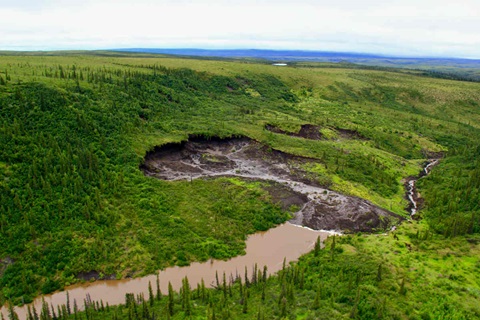Permafrost thaw slumps in the western Canadian Arctic are releasing record amounts of mercury into waterways, according to new research by University of Alberta ecologists.
“Concentrations of mercury were elevated for at least 2.8 kilometres downstream of thaw slumps,” said Kyra St. Pierre, Vanier Scholar PhD student, who co-led the study with fellow graduate students Scott Zolkos and Sarah Shakil in the Department of Biological Sciences. “This suggests that some mercury from thaw slumps may be transported for many kilometres through downstream ecosystems, and into larger waterways.”
Mercury transported has been exacerbated by higher temperatures and increased precipitation in the Canadian Arctic caused by climate change.

“Fluvial concentrations of [total mercury] and [methylmercury] downstream of [retrogressive thaw slumps] on the Peel Plateau (Northwest Territories, Canada) were up to two orders of magnitude higher than upstream, reaching concentrations of 1,200 ng L-1 and 7 ng L-1, respectively, the highest ever measured in uncontaminated sites in Canada,” wrote the authors in the study’s abstract.
“Climate change is inducing widespread permafrost thaw,” said St. Pierre, who conducted the study under the supervision of Assistant Professor Suzanne Tank and Professor Vincent St. Louis. “In regions where this results in thaw slumping, this may release a substantial amount of mercury into freshwater ecosystems across the Arctic.”
However, because the mercury is locked within sediments, the scientists are unsure as to whether this mercury could be consumed by organisms in the area and whether the mercury poses any threat to the security of northern food webs.
The research results indicate that further research on mercury cycling in regions experiencing active permafrost thaw is required. As well, there is a need for studies examining if and how the mercury might enter food webs in surrounding ecosystems.
The research was conducted in partnership between the University of Alberta and the Government of the Northwest Territories in response to Northwest Territories’ community interests in the downstream effects of permafrost thaw.
The paper, Unprecedented increases in total and methyl mercury concentrations downstream of retrogressive thaw slumps in the western Canadian Arctic, was published in Environmental Science & Technology.
Adapted from the original release by Katie Willis at the University of Alberta.








